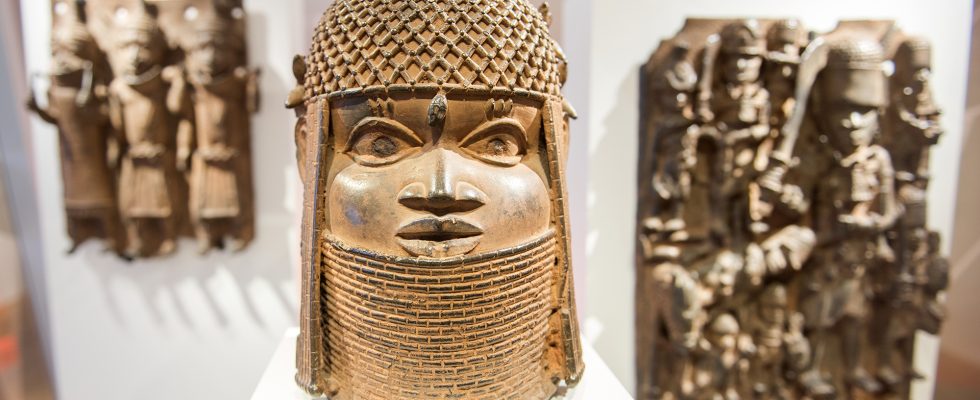Status: 05.04.2023 8:00 p.m
Recently, numerous Benin bronzes have been returned to Nigeria, their country of origin. However, as a study shows, the raw materials for the sculptures come from the Rhineland. From there they took an adventurous route to Africa.
The material for many Benin bronzes comes from the Rhineland between Cologne and Aachen. This was the result of an investigation of lead isotopes in manillas – bracelets made of brass. In the past, they were often melted down to produce the Benin bronzes. This is the result of a study by researchers at the Georg Agricola Technical University in Bochum in the journal “Plos One” has appeared.
Trade agreement with Fuggern
A contract between the German merchant family Fugger and the Portuguese king from 1548 for the delivery of manillas makes the analysis results plausible. “The Rhenish manillas were then transported over 6,300 kilometers to West Africa,” said study author Tobias Skowronek, according to the journal.
What was previously known was that the very uniform lead isotope ratios in many of the Benin bronzes indicate a single major source of material. The use of manillas, which were common currency in West Africa, for metal works of art from the Kingdom of Benin was also clarified.
A manilla attached to part of a Flemish merchant’s pot. The piece was excavated off Getaria in northern Spain.
Image: dpa
Examined numerous manillas
Isotopes are atoms of an element that have an equal number of protons and electrons but differ in the number of neutrons. This can be detected using a mass spectrometer. For the study, the scientists had 67 manillas from five shipwrecks, which were dated to the 16th to 19th centuries. The wrecks lay in African, European and American waters of the Atlantic. Other manillas came from Sweden, Ghana and Sierra Leone.
Skowronek and his colleagues investigated lead isotope ratios on the one hand and the proportion of trace elements such as antimony, nickel, arsenic and iron on the other. Despite the designation Benin bronzes, most of the works of art are made of brass, which mainly contains copper and zinc, but often also lead, tin and other elements.
The raw materials were spatially assigned using a register: “Here at the German Mining Museum, we have a database that contains around 12,000 lead isotope ratios from deposits from all over the world. Both the early manillas and the Benin bronzes made from them bear an amazing resemblance to lead zinc ore deposits in the Rhineland,” Skowronek said tagesschau.de.
basis of many bronzes
According to the materials researcher, there are already 700 chemical data and around 200 lead isotope data of the Benin bronzes, so the sculptures did not have to be examined separately. Since this data comes from various international museums, it is statistically very likely that the majority of all sculptures contain material from the Rhineland.
There was already a suspicion that material could have reached West Africa from Germany. However, according to the researchers, it could not be proven that this happened via the manillas. “What surprised me was the extraordinary homogeneity of the lead isotope data of the Benin bronzes – this indicates that the deposits in the Rhineland were exploited for the brass supply of West Africa for many centuries,” says Skowronek.
Brass from the Rhineland coveted
Manillas were produced in Europe almost exclusively for trade with Africa. From the 15th century onwards, it was mainly the Portuguese who traded with West African peoples, later other colonial powers joined them. The bracelets, some of which weighed several kilograms, were mainly used as currency in the slave trade.
According to historical sources, African traders were very picky about the quality of the manillas. The fact that they preferred brass from the Rhineland could have been due to the relatively high lead content (up to 14 percent by weight). “Lead in brass results in an easy-flowing alloy and reduces porosity, making the alloy more suitable for casting,” the study authors write.
Important to spot fakes
Stefan Simon, Director of the Rathgen Research Laboratory at the Berlin State Museums, is very impressed by the study. It is a big step towards clarifying how the raw material got to Benin.
It was particularly important for his laboratory to be able to identify counterfeits based on the material composition. Because after the sensational discovery of the Benin bronzes by the British in 1897, imitations repeatedly found their way onto the art market. Age determination was also important.
Lars-Christian Koch, director of the Ethnological Museum of the Berlin State Museums, assumes that the findings from the study will not change the debate about the return of the Benin bronzes to Nigeria very much. There had already been criticism of the return from some quarters, partly because the manillas were also used in the slave trade.
“It is important for us that we pursue new research approaches together with our partners in Nigeria,” says Koch. Because even scientific analyzes are dependent on ethnological and other humanities findings as well as on historical sources and traditions for interpretation.

